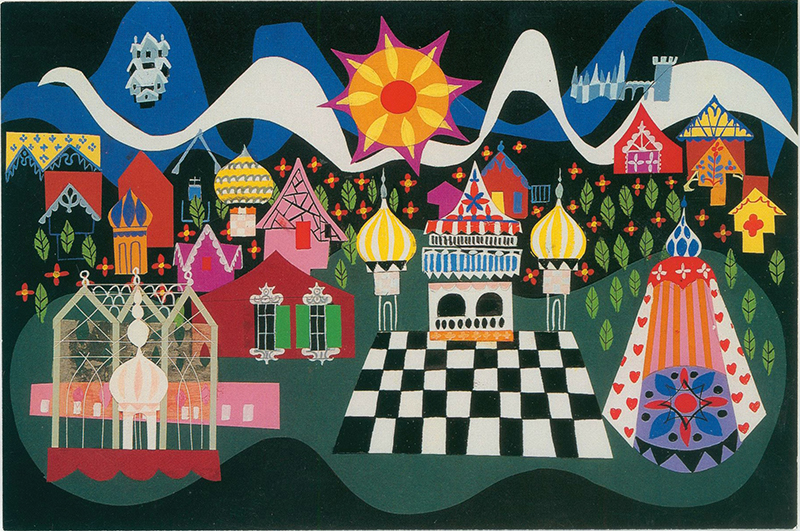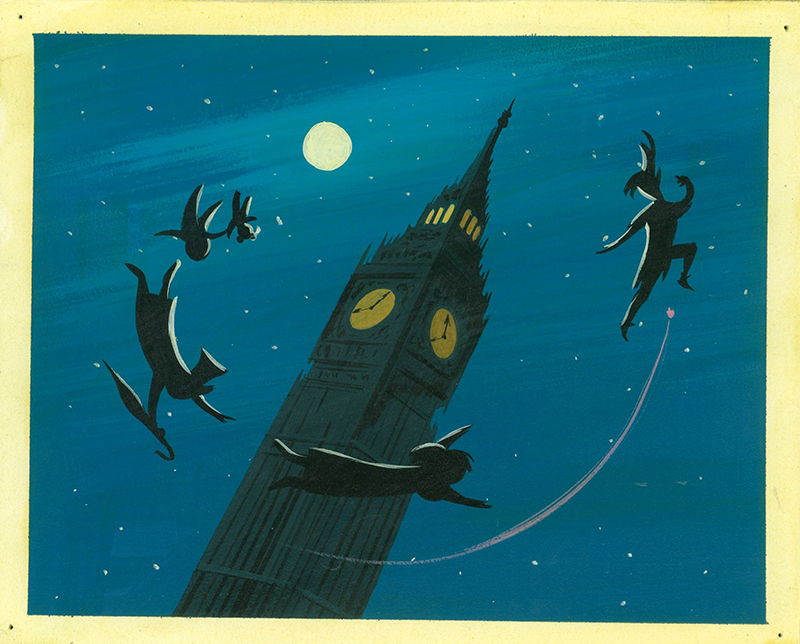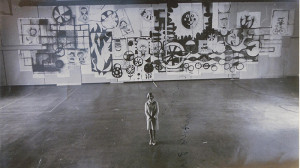Maybe you’ve already been seduced by the colorful banners that line Lombard Street, showing the way to the Walt Disney Family Museum’s latest exhibit. Or perhaps you were charmed by the show’s catchy title: “MAGIC, COLOR, FLAIR: the world of Mary Blair.” But if you still have your doubts when you step into the exhibit, then the exquisite trio of watercolors that first greet visitors should convince you to delve further into this artist’s delightful world.
Though painted in the 1930s during Blair’s student days at the Chouinard School of Art, those three pieces — The Revelation, The Expectation, and The Invitation. — exemplify her ease with both visual media and human emotions. They show very different scenes: the discovery of a creepy old mirror by a Sherlock Holmes-like figure, a young woman’s sly smile as she catches a man’s attention with a dropped handkerchief, and another, less bold young lady hesitating by her father’s side before accepting a young man’s proposal. But as in all her subsequent work, Blair deftly captures each character’s state of mind in these moments while evoking movement and context through telling details, such as a hand gesture or the angle of a gaze.

Blair’s dynamic portrayals of emotions and relationships served her well when she became a concept artist in Disney’s Character Model Department. In a later piece, she depicts Alice growing alarmingly tall in Wonderland but adds a touch of humor by including a surprised cow looking on from the neighboring field. Disney himself valued and nurtured Blair’s work throughout her long career in a variety of ways: from choosing her to travel with other Disney artists on a goodwill tour of South America, to commissioning her to design theme park attractions including it’s a small world. In between, she helped pull the studio out of a post-war slump by designing three of the most well-known Disney films: Cinderella in 1950, Alice in Wonderland in 1951, and Peter Pan in 1953.
The popularity of Blair’s work offers the creators of this exhibition an interesting challenge. Although many may not know of Blair herself, it is safe to say that most visitors will have seen the films she helped produce. The curators handle this by focusing on Blair’s concept art and allowing visitors to draw on their prior knowledge of the finished films. One room of the exhibit shows film clips, but these are from older, lesser-known shorts. Instead of clips or stills, the exhibition spotlights historical footage from Blair’s trip to South America and sketches from her notebooks (tastefully displayed via iPad).

Even so, the exhibit never feels directed at Disney connoisseurs or animation nerds. Blair’s paintings can easily be appreciated without reference to the films and, in some cases, may even surpass the final product. She lent a gothic tone to Cinderella, an unsettling dis-proportionality to Alice in Wonderland, and a ghostly air to Peter Pan that don’t show up as clearly in the films. Her work on Peter Pan practically glows with richer colors than any film could reproduce. Blair’s art allows us to glimpse a missing link between older, darker fairy tales and Disney’s whitewashed adaptations. Her characters are not the perfect, button-nosed kids we expect from Disney – their hair smudges out at strange angles, and their bodies remain chubby with baby fat while their faces express startlingly adult emotions. Blair captured the weirdness as well as the enchantment so prevalent in the original fairy tales and explored the humanity at the heart of all of them. So it is fitting that this exhibit allows us draw back the curtain on Disney magic and get to know one of the individuals who made it happen.


